+ Open data
Open data
- Basic information
Basic information
| Entry | Database: PDB / ID: 8xsi | ||||||
|---|---|---|---|---|---|---|---|
| Title | SARS-CoV-2 RBD + IMCAS-364 (Local Refinement) | ||||||
 Components Components |
| ||||||
 Keywords Keywords | VIRAL PROTEIN/IMMUNE SYSTEM / SARS-CoV-2 / broadly neutralizing antibodies / VIRAL PROTEIN-IMMUNE SYSTEM complex | ||||||
| Function / homology |  Function and homology information Function and homology informationMaturation of spike protein / viral translation / Translation of Structural Proteins / Virion Assembly and Release / host cell surface / host extracellular space / suppression by virus of host tetherin activity / Induction of Cell-Cell Fusion / structural constituent of virion / entry receptor-mediated virion attachment to host cell ...Maturation of spike protein / viral translation / Translation of Structural Proteins / Virion Assembly and Release / host cell surface / host extracellular space / suppression by virus of host tetherin activity / Induction of Cell-Cell Fusion / structural constituent of virion / entry receptor-mediated virion attachment to host cell / host cell endoplasmic reticulum-Golgi intermediate compartment membrane / receptor-mediated endocytosis of virus by host cell / membrane fusion / Attachment and Entry / positive regulation of viral entry into host cell / receptor-mediated virion attachment to host cell / receptor ligand activity / host cell surface receptor binding / fusion of virus membrane with host plasma membrane / fusion of virus membrane with host endosome membrane / viral envelope / virion attachment to host cell / SARS-CoV-2 activates/modulates innate and adaptive immune responses / host cell plasma membrane / virion membrane / identical protein binding / membrane / plasma membrane Similarity search - Function | ||||||
| Biological species |   Homo sapiens (human) Homo sapiens (human) | ||||||
| Method | ELECTRON MICROSCOPY / single particle reconstruction / cryo EM / Resolution: 2.1 Å | ||||||
 Authors Authors | Tong, Z. / Cui, Y. / Xie, Y. / Tong, J. / Gao, G.F. / Qi, J. | ||||||
| Funding support |  China, 1items China, 1items
| ||||||
 Citation Citation |  Journal: Cell Rep / Year: 2024 Journal: Cell Rep / Year: 2024Title: Deciphering a reliable synergistic bispecific strategy of rescuing antibodies for SARS-CoV-2 escape variants, including BA.2.86, EG.5.1, and JN.1. Authors: Zhou Tong / Jianyu Tong / Wenwen Lei / Yufeng Xie / Yingzi Cui / Guowen Jia / Shihua Li / Zezhong Zhang / Zhimin Cheng / Xiao Xing / Haiyun Ma / Lan Deng / Rong Zhang / Xin Zhao / Kefang Liu ...Authors: Zhou Tong / Jianyu Tong / Wenwen Lei / Yufeng Xie / Yingzi Cui / Guowen Jia / Shihua Li / Zezhong Zhang / Zhimin Cheng / Xiao Xing / Haiyun Ma / Lan Deng / Rong Zhang / Xin Zhao / Kefang Liu / Qihui Wang / Jianxun Qi / Haomin Huang / Rui Song / Zhaoming Su / Guizhen Wu / Jing Lou / George Fu Gao /  Abstract: The game between therapeutic monoclonal antibodies (mAbs) and continuously emerging severe acute respiratory syndrome coronavirus 2 (SARS-CoV-2) variants has favored the virus, as most therapeutic ...The game between therapeutic monoclonal antibodies (mAbs) and continuously emerging severe acute respiratory syndrome coronavirus 2 (SARS-CoV-2) variants has favored the virus, as most therapeutic mAbs have been evaded. Addressing this challenge, we systematically explored a reproducible bispecific antibody (bsAb)-dependent synergistic effect in this study. It could effectively restore the neutralizing activity of the bsAb when any of its single mAbs is escaped by variants. This synergy is primarily attributed to the binding angle of receptor-binding domain (RBD)-5, facilitating inter-spike cross-linking and promoting cryptic epitope exposure that classical antibody cocktails cannot achieve. Furthermore, RBD-5 with RBD-2, RBD-6, and RBD-7, alongside RBD-8, also exhibit significantly enhanced effects. This study not only shifts the paradigm in understanding antibody interactions but paves the way for developing more effective therapeutic antibodies against rapidly mutating SARS-CoV-2, with Dia-19 already showing promise against emerging variants like BA.2.86, EG.5.1, and JN.1. | ||||||
| History |
|
- Structure visualization
Structure visualization
| Structure viewer | Molecule:  Molmil Molmil Jmol/JSmol Jmol/JSmol |
|---|
- Downloads & links
Downloads & links
- Download
Download
| PDBx/mmCIF format |  8xsi.cif.gz 8xsi.cif.gz | 117 KB | Display |  PDBx/mmCIF format PDBx/mmCIF format |
|---|---|---|---|---|
| PDB format |  pdb8xsi.ent.gz pdb8xsi.ent.gz | 79.7 KB | Display |  PDB format PDB format |
| PDBx/mmJSON format |  8xsi.json.gz 8xsi.json.gz | Tree view |  PDBx/mmJSON format PDBx/mmJSON format | |
| Others |  Other downloads Other downloads |
-Validation report
| Summary document |  8xsi_validation.pdf.gz 8xsi_validation.pdf.gz | 1002.1 KB | Display |  wwPDB validaton report wwPDB validaton report |
|---|---|---|---|---|
| Full document |  8xsi_full_validation.pdf.gz 8xsi_full_validation.pdf.gz | 1003.6 KB | Display | |
| Data in XML |  8xsi_validation.xml.gz 8xsi_validation.xml.gz | 33.4 KB | Display | |
| Data in CIF |  8xsi_validation.cif.gz 8xsi_validation.cif.gz | 46 KB | Display | |
| Arichive directory |  https://data.pdbj.org/pub/pdb/validation_reports/xs/8xsi https://data.pdbj.org/pub/pdb/validation_reports/xs/8xsi ftp://data.pdbj.org/pub/pdb/validation_reports/xs/8xsi ftp://data.pdbj.org/pub/pdb/validation_reports/xs/8xsi | HTTPS FTP |
-Related structure data
| Related structure data |  38619MC 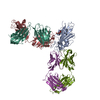 8xseC 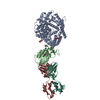 8xsfC 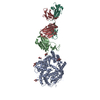 8xsjC 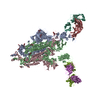 8xslC 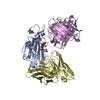 8y0yC M: map data used to model this data C: citing same article ( |
|---|---|
| Similar structure data | Similarity search - Function & homology  F&H Search F&H Search |
- Links
Links
- Assembly
Assembly
| Deposited unit | 
|
|---|---|
| 1 |
|
- Components
Components
| #1: Protein | Mass: 23513.389 Da / Num. of mol.: 1 / Fragment: RBD domain Source method: isolated from a genetically manipulated source Source: (gene. exp.)  Gene: S, 2 / Production host:  Homo sapiens (human) / References: UniProt: P0DTC2 Homo sapiens (human) / References: UniProt: P0DTC2 |
|---|---|
| #2: Antibody | Mass: 50018.180 Da / Num. of mol.: 1 Source method: isolated from a genetically manipulated source Source: (gene. exp.)  Homo sapiens (human) / Production host: Homo sapiens (human) / Production host:  Homo sapiens (human) Homo sapiens (human) |
| #3: Antibody | Mass: 23313.840 Da / Num. of mol.: 1 Source method: isolated from a genetically manipulated source Source: (gene. exp.)  Homo sapiens (human) / Production host: Homo sapiens (human) / Production host:  Homo sapiens (human) Homo sapiens (human) |
| #4: Sugar | ChemComp-NAG / |
| Has ligand of interest | N |
-Experimental details
-Experiment
| Experiment | Method: ELECTRON MICROSCOPY |
|---|---|
| EM experiment | Aggregation state: PARTICLE / 3D reconstruction method: single particle reconstruction |
- Sample preparation
Sample preparation
| Component |
| ||||||||||||||||||||||||
|---|---|---|---|---|---|---|---|---|---|---|---|---|---|---|---|---|---|---|---|---|---|---|---|---|---|
| Molecular weight | Experimental value: NO | ||||||||||||||||||||||||
| Source (natural) |
| ||||||||||||||||||||||||
| Source (recombinant) |
| ||||||||||||||||||||||||
| Details of virus | Empty: NO / Enveloped: NO / Isolate: STRAIN / Type: VIRION | ||||||||||||||||||||||||
| Buffer solution | pH: 7.4 | ||||||||||||||||||||||||
| Specimen | Embedding applied: NO / Shadowing applied: NO / Staining applied: NO / Vitrification applied: YES | ||||||||||||||||||||||||
| Vitrification | Instrument: FEI VITROBOT MARK IV / Cryogen name: ETHANE / Humidity: 100 % / Chamber temperature: 277 K |
- Electron microscopy imaging
Electron microscopy imaging
| Experimental equipment |  Model: Titan Krios / Image courtesy: FEI Company |
|---|---|
| Microscopy | Model: FEI TITAN KRIOS |
| Electron gun | Electron source:  FIELD EMISSION GUN / Accelerating voltage: 300 kV / Illumination mode: FLOOD BEAM FIELD EMISSION GUN / Accelerating voltage: 300 kV / Illumination mode: FLOOD BEAM |
| Electron lens | Mode: BRIGHT FIELD / Nominal defocus max: 2000 nm / Nominal defocus min: 1000 nm |
| Image recording | Electron dose: 40 e/Å2 / Film or detector model: GATAN K3 (6k x 4k) |
- Processing
Processing
| CTF correction | Type: PHASE FLIPPING AND AMPLITUDE CORRECTION | ||||||||||||||||||||||||
|---|---|---|---|---|---|---|---|---|---|---|---|---|---|---|---|---|---|---|---|---|---|---|---|---|---|
| 3D reconstruction | Resolution: 2.1 Å / Resolution method: FSC 0.143 CUT-OFF / Num. of particles: 594696 / Symmetry type: POINT | ||||||||||||||||||||||||
| Refine LS restraints |
|
 Movie
Movie Controller
Controller








 PDBj
PDBj







